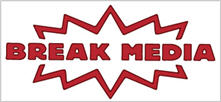-
Break Media Gains Momentum With Branded Content in 2009
Break Media, the male-focused online entertainment community, is announcing this morning strong results for its branded content campaigns. Year-to-date the company has completed 25 branded content campaigns, totally over 80 videos vs. 16 campaigns and 60 videos for all of 2008.
Break's branded content focus helped the company achieve its best revenue month in history in August and to project an 18% increase in full year '09 revenue vs. '08, noteworthy accomplishments given the recent nosedive in ad spending. To learn more about Break's branded content initiatives and overall results, yesterday I spoke to Andrew Budkofsky, Break's SVP of Sales and Business Development.
For those not familiar with the term "branded content" or "branded entertainment," these refer to advertiser-funded online video or multimedia projects that have strong brand placement (and frequently strong product placement as well). Branded content differs from conventional ad-supported media in a couple of important respects. First, in conventional media, creative projects are developed without sponsor involvement, whereas in branded content, the sponsor has strong input and sometimes full control of the creative process. This can lead to significant product placement. And second, in conventional media, ads are usually sold concurrent with or subsequent to production, whereas in branded content, sponsor funding is typically secured in advance of production beginning (with the sponsor's budget guiding the production budget).
Break takes an interesting approach to branded content. It doesn't explicitly charge clients for branded content development. Instead it allocates a percentage of the client's media buy on Break's various media
 properties to develop branded content as a pure value add to the media buy. Andrew wouldn't specify what percentage is allocated, except to say it's typically "more than 10%, but really varies by client." Client campaigns need to be at least in the low 6 figures to qualify for branded project development. Break beefed up its creative resources earlier this year through the acquisition of HBOlab. Andrew believes that Break's approach gives it a meaningful differentiator when bidding on client RFPs.
properties to develop branded content as a pure value add to the media buy. Andrew wouldn't specify what percentage is allocated, except to say it's typically "more than 10%, but really varies by client." Client campaigns need to be at least in the low 6 figures to qualify for branded project development. Break beefed up its creative resources earlier this year through the acquisition of HBOlab. Andrew believes that Break's approach gives it a meaningful differentiator when bidding on client RFPs. While clients and their agencies closely assess the performance of their Break media buy, because the branded content piece is positioned as a value-add, the metrics around its performance are not as strict. Andrew said that primarily clients are looking at number of views, but also look at brand recall, favorability, engagement and other gauges. Break doesn't guarantee clients a minimum number of views for their branded content, but it knows from doing many projects and understanding its site statistics what types of promotional placements will yield what level of views. Break also actively pursues social media distribution, trying to get a video go viral.
Recent examples of Break's branded content include Levi's "Stories of a New America," Castrol's "Urban Car Legends" and KFC's "Getting Grilled." All are multi-part series that are cleverly produced, with expenses minimized through sparse sets, unknown talent and short durations. From my vantage point they all work well creatively and also in support of their respective brands. The Levi's and Castrol series both generated over 1 million viral views.
Break's focus on the young male audience gives it an edge in winning clients looking to reach this segment. But it's not alone in the branded content area. Andrew cited agencies' in-house branded content departments as both competitors and potential partners, along with portals. Recent examples of non-Break produced branded content I've followed include Verizon-MTV's "Valemont," NBCU-American Family Insurance's "In Gayle We Trust," Sara Lee's "Mama Saga" and Lexus's "Web Therapy" among others.
With the ongoing pinch in ad-spending and strong brand motivation to experiment and breakthrough in the evolving new media landscape, branded content looks poised to accelerate. Break, with its creative resources, well-baked approach and strong distribution to the young male market segment, seems well-positioned to continue benefiting.
What do you think? Post a comment now.

